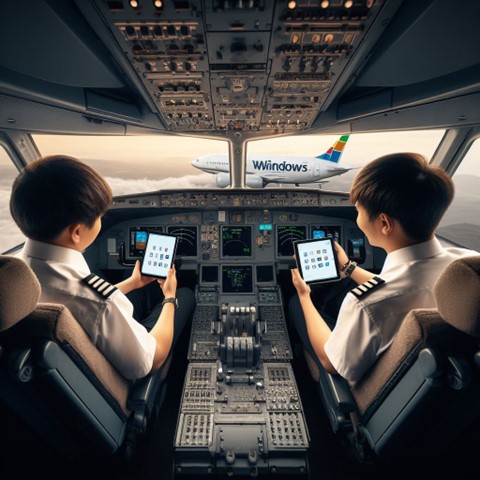3 Tips to Land Microsoft Copilot Successfully in Your Enterprise

It’s called Microsoft Copilot, not Microsoft Captain, for a reason.
First things first, I love large language models, OpenAI’s ChatGPT and all things Microsoft. With its launch on November 1st, Microsoft 365 Copilot is poised to transform the way we interact with and create content in all areas of work. The only thing I can really compare it to in my 20+ years in IT was the change which came about through the widespread deployment of high-speed internet. This one thing changed not only what we consume, but where we consume it and even how we work as a society.
I believe we are on the crux of Microsoft introducing this type of service to the masses. However, we have to understand that just like it took some time for high-speed wireless to become the standard, Copilot will need some time to get there. Luckily, that doesn’t mean we can’t benefit from it now, as long as we use it in the right way.
In thinking about this, my thoughts naturally turned to aviation. Everyone who has climbed aboard a commercial airliner is used to seeing two pilots sitting in the front of the plane. The reality is, even though they may look very similar in appearance, they have two very distinct roles. The captain, who sits on the left, is in charge and responsible for everything that happens on the plane. The copilot (first officer) sitting on the right is there to assist the captain by managing the information workload, completing routine tasks and helping to keep the captain on track.
Microsoft Copilot is poised to be a great copilot for you and your work. However, let’s make sure your expectations and use of it sets you up for success. This really starts with understanding how to interact with your copilot.
Tip 1: Remember, Copilot does not know the difference between good information and bad information.
How helpful would a copilot be if their training material, checklists and knowledge of the objectives of the flight were based on conflicting or incomplete information?
If you are like me, you have access to tons of versions of documents, emails, Teams chats, SharePoint data, etc. Of those, some have 100% correct information, some are roughly 75% correct and some are outright wrong. Copilot will use all of that information to create new content when you ask a question. Therefore, you really need to think about what data you are asking Copilot to leverage to answer your questions.
If you ask Copilot for Microsoft Teams to summarize a meeting with key points, do you know if everyone on the transcript for that meeting is 100% accurate? Is there a chance someone said something incorrect on the technical specs, referenced inaccurate client names, case law or said something like “Bob told me…”? All of this will be used by Copilot, and it can’t be expected to know truth from reality. Remember, just like the captain, you are responsible for accuracy and completeness of the data. Question everything.
Tip 2: You only get one chance to make a first impression.
How would you feel if you walked down the jetway for your next flight and came across the captain in an untucked shirt, stained trousers and his mouth full of a half-eaten burger?
When you are looking to introduce Microsoft Copilot to your company, consider the approach of phasing in licensing for Copilot with a small team at first. First impressions will be important. Identify a group of users who are not only curious but willing to put in the time to learn how to interact with copilot to get the best possible results in your environment (and a vocal champion of the technology). You are going to need this at $30/month per person to sell its value to the business.
Anyone who has worked with ChatGPT knows that you can learn “better” ways to have an ongoing discussion with it to get what you want. It is like learning the local lingo. It might all be based on the same language, but the way you ask something can change the quality of the output.
In a practical sense, this can mean the difference between you spending 10 minutes error checking and cleaning up Microsoft Copilot’s output to spending an hour getting the same result. You should look at ways to take advantage of your early adopter’s lessons with your data to share “killer questions.” Consider a weekly email or place on your intranet, a dedicated Teams Chat or similar, which gives your employees a chance to share their positive experiences to help others stand on the shoulders of these early adopters to gain the most value from Microsoft Copilot.
Tip 3: Don’t ask a question, have a conversation.
What this means in more a practical sense is not asking “a question,” but more a series of requests to drive towards an output which requires as little as possible refinement after. In this, the key is to be as descriptive as possible. Here is an example of a good question to start with.
“I want to create a RACI for a statement of work. My company, ivision, will be leading the effort to migrate services from the acquired company’s tenant, named source.com, into the corporate tenant, named target.com. The services we will migrate include SharePoint Online, OneDrive, Teams and numerous Power Apps. Can you create a RACI for this work? Please focus on the technical details which will be required, but also include business and project management responsibilities. The ivision roles on the project will be an architect, migration engineer and project manager. The client will have similar roles, as well as a service desk for client support. The client’s name is Bob’s Construction.”
Again, remember you are having a conversation, not a Q/A.
You should expect to refine the response you get with several follow up questions. Don’t take the first response as the best. For example, in the last question, I followed up with “Please increase the number of steps which will happen as part of the Power Apps migration.” This follow-up question added 13 additional rows to the RACI. However, the table it provided just had items for Power Apps. Therefore, I finished up with, “Please combine these with the previous table to create one single table with all items.” Now I had something I could begin verifying and editing.
Summary
Microsoft is getting ready to start phasing in Microsoft Copilot licensing for enterprise customers on November 1st. There will be additional requirements these customers such as a minimum number of seats (300), only being available as an add on top of existing Microsoft 365 E3/E5 licensing and the need to work through their Microsoft Rep to purchase this initially. The specific date for other Licensing types, such as NCE (the new name for a per seat licensing/CSP for smaller customers), has not yet been announced. However, it’s time to start thinking about your enterprise adoption program. As you do, remember Microsoft Copilot is about giving you ideas and saving you time. However, you always want to double check what it is saying and not take for granted what it says. You are Captain Sulley on this flight and will take all the credit, as well as the blame, for the end result of your efforts. Use your copilot wisely.
If you are looking for a great partner to be your air traffic controller in landing this plane, reach out to ivision. We are a fully Microsoft Managed Partner with over 18 years of experience helping clients navigate the complexities of deployments, integrations, mergers and even ongoing managed services. If I can personally be of assistance, feel free to reach out at klynch@ivision.com
Afterword:
They say a picture is worth 1,000 words. Microsoft Bing’s Image Creator (powered by DALL-E 3) is another amazing tool we didn’t have access to even a year ago. However, it provides a great visual on the lessons learned and the need to be an active and alert captain of your flight.
I asked Image Creator for the following.
“Can you create a picture of a commercial airliner’s cockpit? It should be shown over the shoulders of the two pilots. The Windows logo should be on the instrument panel. Make it as real as possible.”
How well do you think this flight will end up with just a first pass at that question?

By the way, Jeff Skiles was Captain Sulley’s copilot. 🙂



